Ground Elder
By Mike on Saturday, April 5, 2008, 20:58 - Permalink
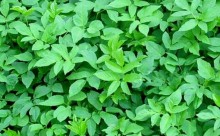 April 05 2008 - Another wild vegetable adventure. Ground Elder is a common and invasive weed in many parts of Britain, including the area where I live.
April 05 2008 - Another wild vegetable adventure. Ground Elder is a common and invasive weed in many parts of Britain, including the area where I live.
I'm fortunate enough not to have it in the garden, but just down the road from me, there's a border that is overrun with the stuff.
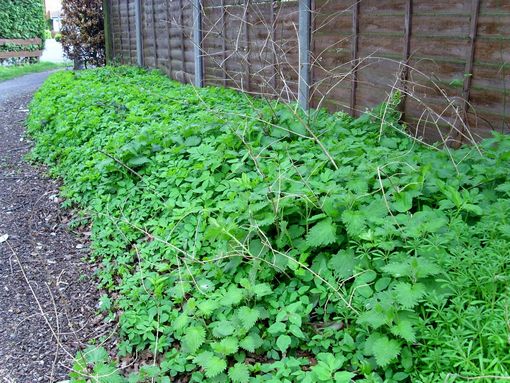
That's cleavers and stinging nettles in the foreground - the rest is Ground Elder.
What is Ground Elder?
Aegopodium podagraria - introduced to Britain from Europe either by the Romans, or during the Norman Conquest - depending on who you ask.
Either way - this was a common and popular vegetable in days gone by.
And it's easy to see why - it's not exactly hard to cultivate! - it's hard to uncultivate - it spreads vigorously by means of underground rhizomes and is almost impossible to eradicate from gardens once it takes hold - particularly if there's a fence or hedge it can keep creeping under from adjacent land.
The leaves and flowers superficially resemble those of Elder trees (Sambucus spp), but it is not closely related at all.
Picking Ground Elder
Spring is a great time to gather it - before the flowers appear, the leaves form a lush carpet and with just a little patience, it's possible to pick only the freshest young shoots.
As with any wild leafy vegetable, it's worth investing this time when picking, as sorting, trimming and cleaning the collected leaves back in the kitchen is much more difficult.
In The Kitchen
Ground Elder is a member of the Umbellifer family - and this is made very obvious by its aroma, which when fresh is a pungent carroty-parsley smell - that fades significantly on cooking.
Cooking
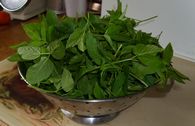 Like most delicate leafy vegetables, it requires minimal cooking - the easiest way to do this is to rinse the leaves (chopping them a little if desired) then dump them on top of a little melted butter in a hot pan - stir, put on the lid and leave to steam in just the residual water clinging to the leaves from rinsing.
Like most delicate leafy vegetables, it requires minimal cooking - the easiest way to do this is to rinse the leaves (chopping them a little if desired) then dump them on top of a little melted butter in a hot pan - stir, put on the lid and leave to steam in just the residual water clinging to the leaves from rinsing.
No more than a few minutes later, the leaves will have wilted - take them off the heat while they are still vivid green and serve immediately.
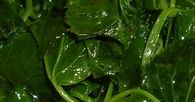 I used them just like this as a green vegetable accompaniment to that classic favourite dish - Bangers and Mash.
I used them just like this as a green vegetable accompaniment to that classic favourite dish - Bangers and Mash.
Bangers and Mash
That's sausages and mashed potato.
Anyone who has ever read British childrens comics - and especially The Beano - will have encountered Bangers and Mash - except that in comics, rather than being a neatly arranged plate of dinner, it was always presented as a gigantic mountain of mash, studded with sausages all over.
I've never seen it served that way in real life, so just for a bit of fun, I thought I'd try it.
The picture below then, is Bangers and Mash - Beano Style - with baked beans and steamed buttered ground Elder (almost making an appearance from the edge of the frame - I just got so carried away with eating it that I forgot to take a picture of it on its own)..
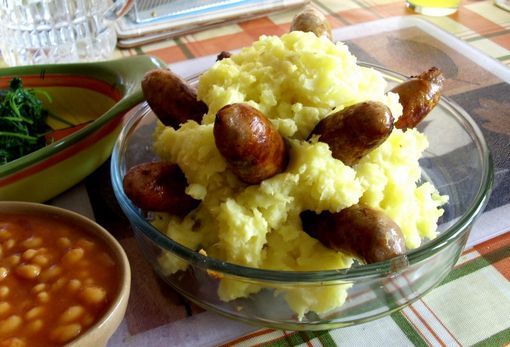
What's it like?
Unusual - the texture is leafy, like kale. the flavour is unusual - mostly mildly celery/parsley-like, but with a slight bitter tang to it.
I'm going to experiment a bit with this and see what else I can do with it - I reckon it ought to work fairly well as an interesting substitute for flat leaf parsley.
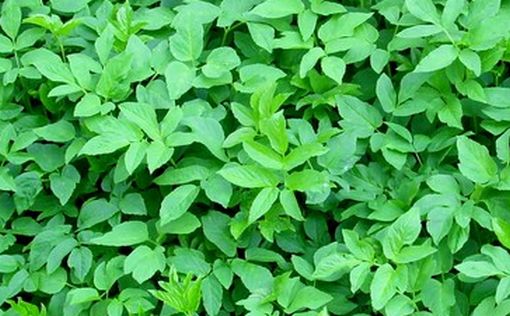
Cautionary Note
Ground Elder is an invasive, vigorous plantIt will readily become a troublesome weed if introduced to your garden.
When picking it - particularly later in the season when the stalks are tougher and the roots tend to pull up along with the leaves - take care to discard any roots immediately at the picking site - if you take them home and they end up in your compost heap, they may grow and invade your garden.
